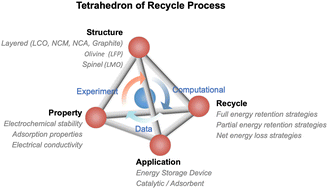Carbon neutrality strategies for sustainable batteries: from structure, recycling, and properties to applications
Abstract
Research on new energy storage technologies has been sparked by the energy crisis, greenhouse effect, and air pollution, leading to the continuous development and commercialization of electrochemical energy storage batteries. Accordingly, as lithium secondary batteries gradually enter their retirement period, achieving their efficient and green recycling is not only a strategic requirement for the development of an ecological civilization but also a practical assurance for the secure supply of resources. Herein, we provide a comprehensive explanation of the current lithium secondary battery recycling techniques using the organic tetrahedron of structure–recycle–property–application. In addition, we evaluate the highly promising new generation of future energy storage batteries from multiple dimensions and propose possible recycling technologies based on the current state of lithium-ion battery recycling and recycling theory. Finally, the challenges and future directions for the advancement of key material recycling technologies for lithium secondary batteries and highly promising next-generation batteries with applications are outlined, geared toward initiatives to shift to carbon neutrality.



 Please wait while we load your content...
Please wait while we load your content...